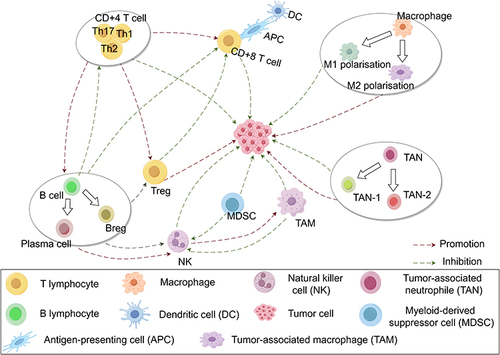Figures & data
Table 1 Mechanisms of Action of Immune Cells
Figure 1 Crosstalk between cancer cells and TME cells. T lymphocytes mainly include CD4+ T cells, CD8+ T cells and Tregs, of which CD4+ T cells can differentiate into T helper 1 (Th1 cells) and T helper 2 (Th2 cells). Th1 cells can enhance the killing ability of T lymphocytes and activate macrophages; Th2 cells can assist B lymphocytes (B cells) to produce specific antigens and exert anti-tumor function; meanwhile, CD4+ T cells can recruit CD8+ T cells and promote tumor growth. Regulatory T cells (Tregs) can reduce NK cells and promote the depletion of effector T cells. TIL-Bs can reduce NK cells and promote the depletion of effector T cells. Secretion of IL-10 or TGF-β by regulatory B cells impairs antitumor immunity and converts quiescent CD4+ T cells into Tregs. NK cells secrete proinflammatory phenotypes that maintain tumor-associated macrophages (TAMs) and tumor-associated neutrophils (TANs). TANs differentiate into TAN-1 and TAN-2, of which TAN-1 inhibits tumor growth and TAN-2 promotes tumor cell proliferation and metastasis. Mature cells (DC cells) have strong antigen-presenting ability, and can block T cell cycle or apoptosis, and induce Treg cell differentiation. Macrophages are mainly polarized into M1 and M2 macrophages, most of which have antigen-presenting capacity.

Table 2 TCM Formulae in Regulating Tumor Microenvironment
Table 3 Herbal Compounds in Regulating Tumor Microenvironment
